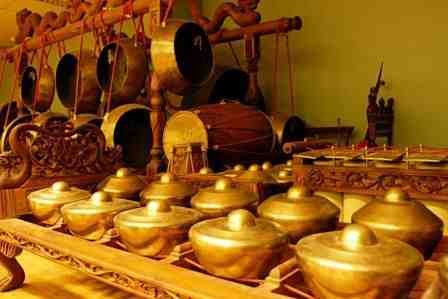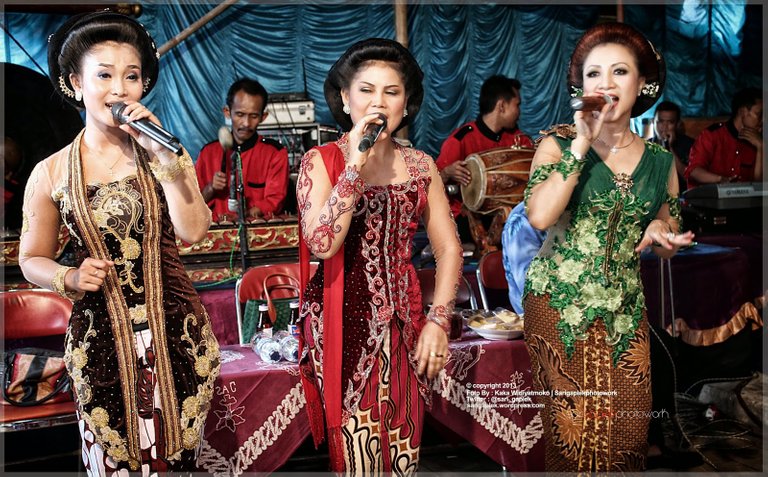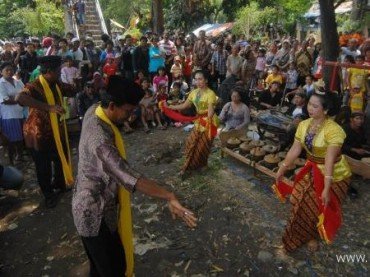
Gamelan is a unified whole the various elements of a musical instrument that is realized and pounded together. The word is derived from the Javanese Gamelan 'Gamel' which means to hit, followed by the suffix '-an' which makes it a noun.
Gamelan is very easy to find in almost all areas of the island of Java. Of course there are some differences between one region to another due to cultural processes. Gamelan growing in Semarang is a Javanese Gamelan. In addition to Java, gamelan also may encounter in Madura, Bali, Lombok, etc. Of these, Javanese Gamelan is believed to be the oldest and the origin of gamelan in other areas.
Occurrences gamelan preceded by Hindu-Buddhist culture that dominated Indonesia, especially Java in the early days of recording history. The instrument was developed to shape up like this in the days of the Majapahit Kingdom. The only Indian influence in gamelan music is how to sing it.
The description of the gamelan was first discovered in the temple of Borobudur, Magelang, Central Java, which was built in the 8th century. Musical instruments such as the bamboo flute, bells, drums in various sizes, harp, stringed musical instrument that is swiped and learned, is found in the relief. However, slightly metallic element found musical instruments. However, relief of the instrument said to be the origin of the gamelan.
In his book 'Music in Java' Jaap Kunst, a leading Dutch ethnomusicology, described gamelan comparable only to two things: moonlight and flowing water. "Gamelan is comparable to only two things, moonlight and flowing water. ... Mysterious like moonlight and always changing like flowing water ...", he wrote.
Gamelan is an integral part in almost all Javanese arts and cultural activities, such as puppet show, Kethoprak, dance performances, uyon-uyon (performing art of singing), etc. Gamelan music performances can be staged as a separate or as background music in a show. As a show of its own, gamelan music is usually combined with the voice of the singer Java (called wiraswara male singers and female singers called waranggana).
A set of gamelan consists of a variety of musical instruments and each instrument has a different function. The main constituent component of the gamelan music is dominated by metal elements, bamboo and wood. Musical instruments constituent gamelan namely: Kendang, Saron, Bonang barung, Bonang Successor, Slentem, Gender, Xylophone, Gong, Kempul, Kenong, Ketug, Clempung, zither, flute, fiddle, drum, keprak and Kepyak.
Tuning and manufacture gamelan orchestra is a complex process. Gamelan using four ways tuning, ie SLA © ndro, PA © log, "Degung" (special area of Sunda, or West Java), and "madenda" (also known as diatonic, the same as the original minor scale that is widely used in Europe.
Slendro has five basic tone with a small interval difference. While Pelog has seven basic tone with a big interval difference. Gamelan music composition created with some rules, which consists of several rounds and pathet, capped by a gong and the melodies were created in a unit consisting of 4 tones
Gamelan is one of the cultural products that have been recognized internationally and performed on five continents. Even the United Nations has set as a cultural heritage that should be protected and preserved.

Campur Sari
Campursari term in the world of national music Indonesia refers to the mixture (crossover) some contemporary Indonesian music genre. Campursari name is taken from the Java language is actually a general nature. Music campursari in the area of central Java to the east, especially related to the modification of gamelan musical instruments that can be combined with western musical instruments, or vice versa. In fact, the instruments 'foreign' this 'subject' in the grip of music preferred by local communities and gending Java style.
Campursari first popularized by Manthous by incorporating keyboards into the gamelan orchestra in the late 1980s through the ensemble "Forward Current". Then rapidly enter new elements such as Java style (kroncong) and finally dangdut. In the decade of the 2000s was known forms campursari which is a mixture of gamelan and keroncong (eg Kena Goda of Nurhana), a mixture of gamelan and dangdut, and mixtures keroncong and dangdut (congdut, popular songs Didi Kempot). Despite the development of campursari much criticized by proponents of purity streams of music, all parties agreed that campursari revitalize traditional music in the land of Java.
Tayub
RHYTHM music floated in a melodious voice. The sound of gongs, drums combined with smart rhythms intertwined, spurring the spirit of a dancer tayub swaying tirelessly. His expression expressive looks with graceful motion, they dance to the rhythm of songs of popular Java. Some look a little attractive, very seductive attention of the guests. This art is indeed very beautiful to watch. As if not tired eyes fixed on the dancers.
Tayub Art is already familiar, especially to people in Sragen and the surrounding area. Tayub is a performance art that is considered a folk art that first appeared in the era of the kingdom of Singosari. Performances tayub residents now commonly held to enliven the circumcision ceremony and wedding.
Tayub was originally an expression of joy to greet guests and are part of a party of the people. This art form of dance performances that shaped pairs between tledhek or joged with male dancers as penayub. Tayub dancers usually start the stage by bringing Tari Gambir Anom, a classical dance with gentle force. Afterwards, they danced the rhythms are a little smart. What is unique about this dance is the participation of the audience or guests to dance along with the dancers Tayub. Guests were seen as respectable normally be asked to dance with her draped marked a sampur.
On its own terms tayub there are several opinions. RT. Suparno Hadipura, S.Pd one observer arts tayub in District jenar Sragen, said "Tayub" comes from the word "Toto lan Guyub" (styled though compact) order sing guyub, the meaning of behavior and motion must be compact inner and outer. Compact between the dancers, waranggana with male dancers and gamelan.
Suparno call tayub is one of the valuable art. Tayub art, philosophy or pitutur containing high, in the Java language arts tayub meaning "called kang duwe gegayuhan seagrass can nyingkirake ing panggoda utowo pepalang will be kasembadan ing sedya". Meaning in Indonesian, Who have ideals, must be able to withstand all the temptations. The temptation here is symbolized by principal dancer called Tledek and dancer companion was behind tledek called, Panglareh. While symbols are invited to goodness played by Pangarih. Pangarih an escort dancer who is behind Panglaras or the person who gets sampur. Tledek and Panglaras dancers will dance face to face. Tledek and Panglareh will tempt Panlaras. Meanwhile, Pangarih role is to encourage Panglaras be unaffected temptation and invite to goodness.

Art History Tayub
Tayub known since the days of the kingdom of Singosari. First held at the time of King Jumenengan Ametung stumps. Tayub then progressed to the Kingdom of Kediri and Mojopait. In the Age of Empire Demak, art Tayub rarely staged. At the time of the Age of Empire Demak, Tayub art can only be found in rural areas-the countryside far from the city center of the kingdom.
Over time, since the founding of the kingdom Pajang and Mataram, this art began to be exhumed. Even at that time tayub made Beksan dance in the palace, which was held only during special occasions. Regrettably, however, the Dutch colonists incorporate negative elements known as 3C, Kiss, Ciu and Flick. "In the dance included liquor, the goal that disrupt a sense of unity. With a hangover, then people can easily take offense, argue, and so forth. Since then vote against tayub be negative, "he said.
Tayub which has been negatively impacted by the Dutch colonialists continuously maintained until the government held by Sunan Pakubuwono III. When Sunan Pakubuwono held by the government to IV, he was not pleased with their negative influence. Finally Tayub set as the dance Pasrawungan in society. Furthermore tayub art has developed in the area of Sragen, Wonogiri and Purwodadi. In the area of Sragen itself, art Tayub widely grown in the District jenar, Gesi, Sukodono, Mondokan and Ngrampal.
Tayub art imagery at the time, aggravated act of the male dancers or spectators. In the past, the dancers used to give sawer by entering a tank top or a cloth covering the chest. Thus arose the impression that penayub it "cheesy". However, in the present era that sort of thing has been very rare.
Great post. Upvoted and followed.
very interesting article, I saw some similar influenced dancers at a filipino festival awhile ago
Follow me i'll follow you back
A very pecualiar culture
thanks for sharing
Found this on SteemBoost.com. Awesome Content Good Job.
100+ votes but so little money lol wth
Great to know about other cultures!!!Keep up the good work
Congratulations @marjuki95! You have completed the following achievement on the Steem blockchain and have been rewarded with new badge(s) :
Click here to view your Board
If you no longer want to receive notifications, reply to this comment with the word
STOPCongratulations @marjuki95! You received a personal award!
Click here to view your Board
Congratulations @marjuki95! You received a personal award!
You can view your badges on your Steem Board and compare to others on the Steem Ranking
Vote for @Steemitboard as a witness to get one more award and increased upvotes!